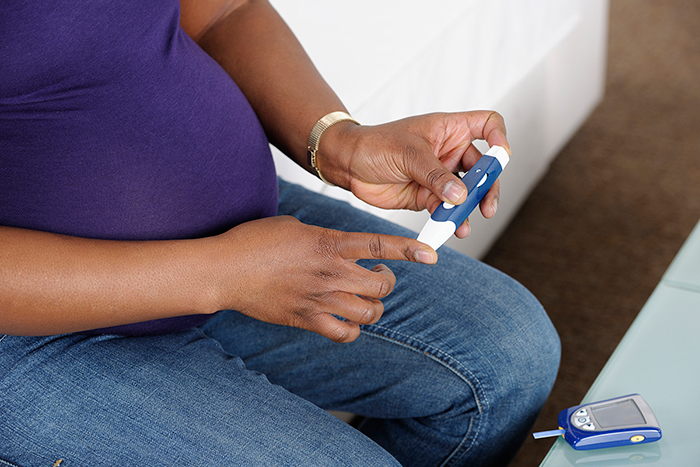Study results suggest that diabetes screening may need to begin in early pregnancy

The excess body fat seen in infants born to women with gestational, or pregnancy-related, diabetes is associated with higher maternal blood sugar levels as early as the 10th week of pregnancy—long before the time when women are usually screened for the condition, according to a study by researchers at the National Institutes of Health. Moreover, weight gain in the fetuses of women with gestational diabetes first becomes apparent in the 28th week of pregnancy, when many women are first tested for the condition.
If the findings are confirmed, it could mean that women should be screened and treated for gestational diabetes as early as the first three months of pregnancy.
The study was led by Cuilin Zhang, M.D., Ph.D., of the Epidemiology Branch of NIH’s Eunice Kennedy Shriver National Institute of Child Health and Human Development (NICHD). It appears in The Lancet: Diabetes & Endocrinology.
Background
Gestational diabetes refers to high blood sugar (glucose) during pregnancy. The condition can be treated, but it is associated with higher risk of maternal high blood pressure and increased body fat for newborns. The larger fetal size may result in problems with labor, including a higher risk of cesarean delivery. Later in life, children born to women who had gestational diabetes are at higher risk for obesity.
Women who don’t have any symptoms of gestational diabetes are usually tested from the 24th to the 28th week of pregnancy, according to the U.S. Centers for Disease Control and Prevention.
Previous studies on the potential effects of a woman’s high glucose levels on growth of the fetus have focused on the last two trimesters of pregnancy. The researchers in the current study examined the potential effects of higher glucose levels beginning in the 10th week of pregnancy.
Results
Researchers analyzed the ultrasound scans and glucose and gestational diabetes test results of more than 2,400 women participating in a study of fetal growth. Of the study participants, 107 (4.4%) had gestational diabetes, and 118 (4.8%) had impaired glucose tolerance—glucose levels above normal, but not high enough to be classified as diabetes. Another 2,020 women had normal glucose tolerance. Compared to the women with normal glucose, fetuses of women with gestational diabetes had a greater estimated fetal weight beginning at 20 weeks of pregnancy, which was statistically significant at 28 weeks through 40 weeks of pregnancy. By week 37, the average estimated weight for fetuses in the gestational diabetes group was about 6.7 pounds, compared to about 6.5 pounds in the normal glucose group.
The researchers also compared the early-pregnancy glucose levels of 101 women who were later diagnosed with gestational diabetes to the glucose levels of 203 women with normal glucose tolerance. In these groups, higher glucose levels at weeks 10 to 14 were associated with larger fetal size at week 20, which reached statistical significance at week 27. By week 37, fetuses in the high glucose group had an average estimated weight of about 6.8 pounds, compared to about 6.3 pounds in the normal glucose group.
Significance
The researchers concluded that, assuming their results are confirmed by other studies, efforts to reduce fetal exposure to high glucose levels may need to begin much earlier than at weeks 24 to 28 of pregnancy.
Reference
Li, Mengying, et al. Glycaemic status during pregnancy and longitudinal measures of fetal growth in a multi-racial US population: a prospective cohort study. The Lancet: Diabetes & Endocrinology. 2020. https://doi.org/10.1016/S2213-8587(20)30024-3 .

 BACK TO TOP
BACK TO TOP